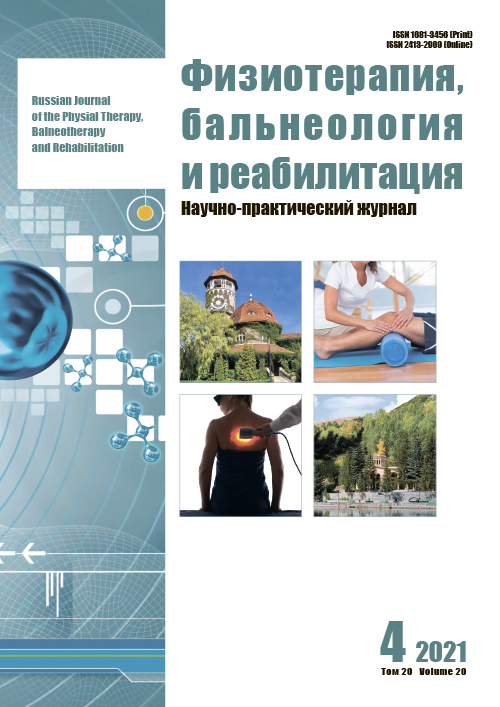Физиотерапия у пациентов с дегенеративно-дистрофическими заболеваниями позвоночника при наличии гемангиомы позвонка
- Авторы: Титов А.А.1, Грушина Т.И.2
-
Учреждения:
- Городская клиническая больница имени М.П. Кончаловского
- Московский научно-практический центр медицинской реабилитации, восстановительной и спортивной медицины
- Выпуск: Том 20, № 4 (2021)
- Страницы: 277-282
- Раздел: Оригинальные исследования
- Статья опубликована: 15.07.2021
- URL: https://rjpbr.com/1681-3456/article/view/107094
- DOI: https://doi.org/10.17816/rjpbr107094
- ID: 107094
Цитировать
Полный текст
Аннотация
Обоснование. При лечении пациентов с дегенеративно-дистрофическими заболеваниями используются различные методы физиотерапии. В качестве противопоказаний к их применению указываются в том числе новообразования позвоночника, доброкачественные образования с тенденцией к росту. При этом в литературных источниках отсутствуют данные о противопоказаниях к физиотерапии при наличии неагрессивной гемангиомы позвонка, равно как и нет научных исследований с доказанным отсутствием негативного влияния на течение данной опухоли.
Цель исследования ― научное обоснование применения физиотерапии у пациентов с дегенеративно-дистрофическими заболеваниями позвоночника при наличии неагрессивной гемангиомы позвонка.
Материал и методы. В исследовании приняло участие 154 пациента с дегенеративно-дистрофическими заболеваниями позвоночника и неагрессивной гемангиомой позвонка. Ретроспективно проанализированы 94 пациента, 60 человек приняли участие в проспективном исследовании. В лечении всех пациентов применяли следующие методы: магнитотерапию, электротерапию, лечебную физкультуру, массаж. Всем пациентам проводилась компьютерная или магнитно-резонансная томография позвоночника до начала лечения и через 1 год по его окончании с оценкой наличия или отсутствия роста гемангиомы в динамике.
Результаты. Среди 94 пациентов с дегенеративно-дистрофическими заболеваниями позвоночника в сочетании с неагрессивной гемангиомой позвонка, получивших различные методы физиотерапии, при повторном исследовании через 1 год выявлена доля случаев увеличения размеров гемангиомы позвонка, при этом ни одна из них не приобрела признаков агрессивности. Минимальная частота увеличения размеров гемангиомы позвонка отмечена у больных после проведения лечебной физкультуры, магнитотерапии, массажа. В результате применения магнитотерапии, электротерапии, лечебной гимнастики и массажа у 60 больных второго этапа исследования рост гемангиомы позвонка выявлен только в одном случае.
Заключение. Локальная низкочастотная электротерапия, магнитотерапия, лечебная физкультура и лечебный массаж спины не оказывали существенного влияния на частоту случаев увеличения размеров гемангиомы позвонка при дегенеративно-дистрофических заболеваниях позвоночника. Возможность использования других методов физиотерапии в лечении больных с неагрессивной гемангиомой позвонка требует дальнейшего исследования.
Полный текст
Об авторах
Александр Андреевич Титов
Городская клиническая больница имени М.П. Кончаловского
Автор, ответственный за переписку.
Email: titov-al@yandex.ru
ORCID iD: 0000-0002-5866-1739
Россия, Москва
Татьяна Ивановна Грушина
Московский научно-практический центр медицинской реабилитации, восстановительной и спортивной медицины
Email: titov-al@yandex.ru
ORCID iD: 0000-0002-0945-4266
SPIN-код: 5275-6509
д.м.н., профессор
Россия, МоскваСписок литературы
- Молчановский В.В., Тринитатский Ю.В., Ходарев С.В. Немедикаментозные лечебно-реабилитационные мероприятия при неспецифической вертеброневрологической патологии. Т. 6 // В.В. Молчановский, Ю.В. Тринитатский, С.В. Ходарев. Вертеброневрология: монография. Ростов-на-Дону, 2016. 619 с.
- Николаев Ю.А., Поляков В.Я., Магомедов М.Г., Севостьянова Е.В. Новые подходы к лечению больных артериальной гипертензией с коморбидной патологией, проживающих в экологических условиях юга Западной Сибири // Юг России: экология, развитие. 2021. Т. 16, № 3. С. 119–126. doi: 10.18470/1992-1098-2021-3-119-126
- Севостьянова Е.В., Николаев Ю.А., Богданкевич Р.И., и др. Комплексная реабилитация пациентов с дорсопатиями поясничного отдела позвоночника и сопутствующим синдромом раздраженного кишечника на базе терапевтической клиники // Вопросы курортологии, физиотерапии и лечебной физической культуры. 2018. Т. 95, № 2. С. 10–18. doi: 10.17116/kurort201895210-18
- Грушина Т.И., Титов А.А. Современные представления о гемангиоме позвонка // Вестник травматологии и ортопедии им. Н.Н. Приорова. 2020. Т. 27, № 1. С. 77–83. doi: 10.17816/vto202027177-83
- Кравцов М.Н., Мануковский В.А., Манащук В.И., Свистов Д.В. Клинические рекомендации «Диагностика и лечение агрессивных гемангиом позвонков». Москва: Ассоциация нейрохирургов России, 2015. 37 с.
- Еремушкин М.А. Классический массаж: учебник. Москва: ГЭОТАР-Медиа, 2016. 448 с.
- Петров К.Б., Ивонина Н.А., Митичкина Т.В. Основные методы лечебной гимнастики у больных вертеброгенными дорсопатиями (лекция) // Вестник восстановительной медицины. 2020. № 1. С. 54–60.
Дополнительные файлы







